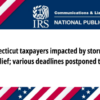Economic status is not etched in stone. The loss of a job or an unexpected illness may push a middle-class family down a notch on the economic ladder. But fortunes can improve, too, with a graduation from college or marriage to an earning partner lifting a lower-income adult into the middle class.
In the United States, the transience of economic status varies significantly across racial and ethnic groups and by level of education, according to a new Pew Research Center analysis of government data. Black and Hispanic adults are more likely than White and Asian adults to move down the income ladder – and less likely to move up it – from one year to the next. Likewise, adults with lower levels of education are more likely than those with more education to see economic regression and less likely to see progression.
In 2021, half of American adults overall lived in middle-income households. But about a third (32%) of those who were in the middle-income tier in 2020 were no longer in that tier in 2021. These adults were equally likely to have moved up to the upper-income tier or down to the lower-income tier – 16% each in each direction – from 2020 to 2021. Some 68% of adults who were in the middle-income tier in 2020 were still in that tier in 2021, during the first year of the coronavirus pandemic.










